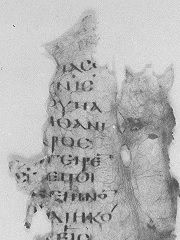 | |
| Name | Vindobonensis Pap. G. 19888 |
|---|---|
| Text | Hebrews 12:19-21,23-25 |
| Date | 4th century |
| Script | Greek |
| Now at | Austrian National Library |
| Size | 15 x 12 cm |
| Type | mixed |
| Category | III |
Uncial 0228 (in the Gregory-Aland numbering), is a Greek uncial manuscript of the New Testament. The manuscript paleographically had been assigned to the 4th century. It contains a small parts of the Epistle to the Hebrews (12:19-21,23-25), on 1 parchment leaf (15 cm by 12 cm). Written in one column per page, 17 lines per page. [1]

A manuscript was, traditionally, any document that is written by hand -- or, once practical typewriters became available, typewritten -- as opposed to being mechanically printed or reproduced in some indirect or automated way. More recently, the term has come to be understood to further include any written, typed, or word-processed copy of an author's work, as distinguished from its rendition as a printed version of the same. Before the arrival of printing, all documents and books were manuscripts. Manuscripts are not defined by their contents, which may combine writing with mathematical calculations, maps, explanatory figures or illustrations. Manuscripts may be in book form, scrolls or in codex format. Illuminated manuscripts are enriched with pictures, border decorations, elaborately embossed initial letters or full-page illustrations. A document should be at least 75 years old to be considered a manuscript.

The New Testament is the second part of the Christian biblical canon, the first part being the Old Testament, based on the Hebrew Bible. The New Testament discusses the teachings and person of Jesus, as well as events in first-century Christianity. Christians regard both the Old and New Testaments together as sacred scripture. The New Testament has frequently accompanied the spread of Christianity around the world. It reflects and serves as a source for Christian theology and morality. Extended readings and phrases directly from the New Testament are incorporated into the various Christian liturgies. The New Testament has influenced religious, philosophical, and political movements in Christendom and left an indelible mark on literature, art, and music.

The Epistle to the Hebrews, or Letter to the Hebrews, or in the Greek manuscripts, simply To the Hebrews is one of the books of the New Testament.
Contents
The Greek text of this codex is mixed. Aland placed it in Category III. [1]

A codex, plural codices, is a book constructed of a number of sheets of paper, vellum, papyrus, or similar materials. The term is now usually only used of manuscript books, with hand-written contents, but describes the format that is now near-universal for printed books in the Western world. The book is usually bound by stacking the pages and fixing one edge to a bookbinding, which may just be thicker paper, or with stiff boards, called a hardback, or in elaborate historical examples a treasure binding.

Kurt Aland, was a German theologian and biblical scholar who specialized in New Testament textual criticism. He founded the Institut für neutestamentliche Textforschung in Münster and served as its first director from 1959–83. He was one of the principal editors of Nestle-Aland – Novum Testamentum Graece for the Deutsche Bibelgesellschaft and The Greek New Testament for the United Bible Societies.
Currently it is dated by the INTF to the 4th century. [1] [2]
The manuscript was added to the list of the New Testament manuscripts by Kurt Aland in 1953. [3]
The codex currently is housed at the Austrian National Library, in Vienna, with the shelf number Pap. G. 19888. [1] [2]

The Austrian National Library is the largest library in Austria, with more than 12 million items in its various collections. The library is located in the Neue Burg Wing of the Hofburg in center of Vienna. Since 2005, some of the collections have been relocated within the baroque structure of the Palais Mollard-Clary. Founded by the Habsburgs, the library was originally called the Imperial Court Library ; the change to the current name occurred in 1920. The library complex includes four museums, as well as multiple special collections and archives.

Vienna is the federal capital and largest city of Austria, and one of the nine states of Austria. Vienna is Austria's primate city, with a population of about 1.9 million, and its cultural, economic, and political centre. It is the 7th-largest city by population within city limits in the European Union. Until the beginning of the 20th century, it was the largest German-speaking city in the world, and before the splitting of the Austro-Hungarian Empire in World War I, the city had 2 million inhabitants. Today, it has the second largest number of German speakers after Berlin. Vienna is host to many major international organizations, including the United Nations and OPEC. The city is located in the eastern part of Austria and is close to the borders of the Czech Republic, Slovakia, and Hungary. These regions work together in a European Centrope border region. Along with nearby Bratislava, Vienna forms a metropolitan region with 3 million inhabitants. In 2001, the city centre was designated a UNESCO World Heritage Site. In July 2017 it was moved to the list of World Heritage in Danger.







